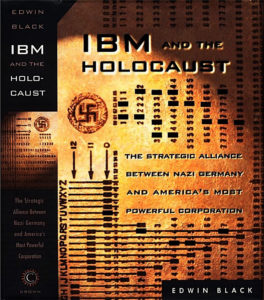Editor's Note (8/11/2020): China has spent years accumulating the personal information of Americans - through TikTok and other social media. Many Americans say, "So, what? What can they do with it?" With history as our guide, it turns out they can do quite a lot. We are far from meeting the challenge posed by the loss of our personal privacy to the communist Chinese government.
If you think you’ve read enough Holocaust-related literature, and if you think there isn’t anything left that can upset you, buy IBM and the Holocaust by Edwin Black. It is at many levels terrible, filthy, and disgusting (other than the author, there is only one hero in the whole 592 pages), but it is an essential story of an American business operating in the cesspool that was Europe in the first half of the twentieth century before, during and after World War II. IBM and the Holocaust is a very, very big story—but its impact hits hardest in very, very small spaces; like two inches on a person’s forearm.
It is also a timely reminder of the potential harm that can come from collusion between big government and big industry, and from the profit motive unmoored from humanity.
IBM and the Holocaust tells how a nifty new twentieth century technology—IBM’s Hollerith machine and punch cards—became the driver for a racist ideology that had previously been technologically constrained in its ability to cause large-scale havoc. Anti-Semitism certainly wasn’t new in Europe, census taking wasn’t new in Europe, and trains weren’t new in Europe. What was new in Europe was the ability of the Nazis to match personal data (including address, business holdings, bank accounts, and church records to see whether someone had been baptized to hide his/her Jewish origin) to train schedules across the continent and to slave labor requirements in camps. To find ethnic Jews as well as religious ones, to find people whose grandparents and great grandparents were Jews, to find people who didn’t want to be Jews or didn’t know they were Jews, to steal their possessions and to exterminate them.
IBM President Thomas Watson’s chief personal ideology appears to have been control of markets and profit—he accepted a medal from Hitler in 1937 (returning it only when in mid-1940 it became a political liability) and had working relationship with FDR and Secretary of State Cordell Hull. He was a member of the “peace camp” to ensure that his German company could remain operative, and worked for U.S. occupation forces after the war. The company made profits in every Nazi-controlled country, but Watson convinced the U.S. government that it was a “victim” of Nazi control so it didn’t pay war reparations.
The book’s title tells the story—IBM came to Germany after WWI and stayed. It produced the 1933 German census, the beginning of the aggregation of information the Nazis used to separate loyal Aryans from others. Across Europe, IBM put its Hollerith machines to work doing much the same thing—when the Nazis arrived to occupy territory, it used existing census data and existing Hollerith machines, and where data was insufficient—as in Holland or Romania—required the populace to register itself. In Poland, by April 1940 the Nazis had opened the Central Statistics Office, where employees processed 600,000 volumes of printed data into punch cards and had the Polish population databased by November 1941. Hollerith machines or sorting operations were put in nearly all of the concentration camps, including Auschwitz, to manage slave labor, and in others, workers wrote up data on sheets that were shipped to central Hollerith processing centers.
There is an enormous amount of information in IBM and the Holocaust and so many long descriptions of how holes were punched, numbers assigned and data processed. Just when the eyes of a non-technically inclined reader (like this reviewer) are about to glaze over, Black switches to the real point—not how many punch cards, how many people; not which numbers fit into which slots; which characteristics of an individual were recorded and to what nefarious end; not how many dollars IBM pulled out of the abyss—but how many people drowned in it.
Have you ever wondered about concentration camp tattoos? Why five digits (occasionally six), which five, and what for? They aren’t consecutive, don’t correspond to birth dates, and don’t appear related to country of origin or anything else easily deduced. The digits were the identification number from IBM Hollerith prisoner cards. Each inmate processed into a work camp had a prisoner number corresponding to a card on file with his/her personal information—birth date, place or origin, language, occupation, particularity (Jew, homosexual, political criminal, etc.). No names. The camps used the cards to produce brigades for slave labor. That the numbers weren’t on the forearm at first was the result of a glitch.
“Soon [the numbers] bore no further relation to Hollerith compatibility for one reason: the Hollerith number was designed to track a working inmate—not a dead one. Once the daily death rate at Auschwitz climbed, Hollerith-based numbering simply became outmoded. Clothes would quickly be removed form any cadaver, making identification for the Hollerith-maintained death lists difficult. So camp numbers were inked onto a prisoner’s chest. But as the chest became obscured amidst growing mounds of dead bodies, the forearm was preferred as a more visible appendage.” (352-353).
Oh.
Moreover, those with tattoos were lucky in the scheme of things—those shipped directly to gas chambers were just counted when they stepped on the train. They wouldn’t survive long enough to warrant the expense of a punch card.
And a hero? Rene Carmille, Comptroller General of the French Army was a Hollerith man. In Lyon, he convinced the General Commission on the Jewish Question (GCJQ) that he could tabulate the information on French Jewry. Given 140,000 census cards at one point, he went to work, and to work, and to work—but no tabulated results emerged. Carmille, it turns out, was spending his time tabulating 800,000 former French soldiers on his Hollerith machines—the backbone of the French Resistance. He also produced 20,000 fake identity cards. Carmille was discovered by the Nazis and died at Dachau in January 1945. Robert Carmille, who had worked on the project with his father, later told Black, “We never punched Column 11.” Column 11 was the column for religion.
IBM and the Holocaust is meticulously sourced, and Black tells of his deep and wide efforts to find flaws in his research; (I don’t recall any from the published product). He also details his efforts to get today’s IBM to share its files and tell its story. The one saving grace of the whole effort might have been IBM’s willingness to come clean about something that happened in a different time, a different place and with an entirely different cast of characters—there is no blood on the hands twenty-first century IBM.
But the company dissembles, hides, obfuscates and lies, bringing new meaning to the slogan, “I’m an IBM-er.”





